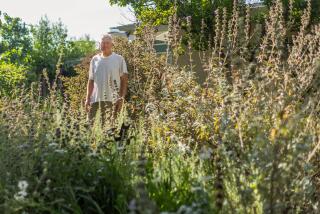Hyacinth bean vine, a versatile addition to the edible garden
- Share via
How could you not love a bean called lablab? Originating in Africa but cultivated in India since Neolithic times, the hyacinth bean (Dolichos lablab) has fed humans and livestock for millenniums. It’s a drought-tolerant vining perennial that can reach 30 feet, ideal for covering a fence or a wall. It grows fast and comes in bushing, creeping and semi-erect varieties, many pretty enough enough to be used as an ornamental.
The purple varieties have brilliant violet flowers and red-purple pods. Like other legumes, it’s a potent nitrogen fixer, helping to enrich the soil.
Of the two main types, green pods and purple pods, some are cultivated strictly as a field crop to produce fodder. Kitchen gardens tend toward the green pod variety seim (pronounced “shim”).
Seim vines aggressively, and in late spring the plant starts churning out fleshy bean pods that can be used like snap peas or green beans in stir-fries, soups and curries. Shelled, the fresh beans work like limas in recipes. Young leaves can be used as a spinach alternative. (Older leaves can get tough.)
Dried hyacinth beans are another matter. No matter the variety, poisonous toxins build as the beans mature. Dried beans are especially popular in India, where they are used in dal and other dishes. The dried beans have to be be double-cooked, with the water changed twice.
At the Vermont Square Community Garden in L.A., gardener Alimud Chowdhury said his wife insisted that if he was going to work a plot, he had to plant seim. Using seeds from Bangladesh, he and fellow gardener Mohammad Rahman put in plants along a chain link fence.
Rahman said he eats everything: the small leaves, the flowers, the young pods and the shelled beans. Lately, however, he’s been tending more than harvesting. One vine is 8 months old and just starting to recover from the low temperatures of the last few months.
“The leaves die because of the cold,” he said. “If it’s a little cold, no problem. This year it was severe.”
He pointed out where flowers were starting to bud and added that he thought the plant would make it. Seim can last three or four years if conditions are good, he added.
Now is the time to plant hyacinth beans for a late spring harvest that can go on for months. They are easily found online and they start easily, but to extend the plants’ life and maximize harvests, you’ll want to provide a structure for the plant to climb.
The Global Garden, our series looking at multicultural L.A. through the lens of its landscapes, appears here on Tuesdays. We welcome story suggestions at [email protected].






